What Is an Obelisk? – Top 10 Obelisks Found Around the World
What is an obelisk and what does an obelisk represent? Famous obelisks, such as the Egyptian obelisks, were huge four-sided structures built by the ancient people. There are many obelisks around the world, but why are obelisks everywhere, and what role did they play? Let us discover all there is to know about the history of the obelisk shape and its purpose.
What Is an Obelisk?
Egyptian obelisks were often created to commemorate monarchs, and their popularity extended across the ancient world, including Assyria and ancient Rome. Even when these civilizations fell, the obelisk remained a popular monument due to the bold yet simple obelisk shape. Furthermore, some of the world’s most recognizable structures, such as the Washington Monument in Washington, D.C., are variations on the old famous obelisks, and there are still many obelisks around the world.
Before we explore a few famous obelisks, let us first start with the history of the obelisk.
The History of the Obelisk
The obelisks of the ancient world were monolithic constructions, meaning they were fashioned from a single block of stone and were built in pairs for temple entrances. The obelisk shape is linked with Ra, the ancient Egyptian sun deity. The engravings on all four sides of most antique Egyptian obelisks are devoted to Ra and the sovereign who constructed the monument. Why are obelisks everywhere now though? Following Cleopatra’s death in 30 BCE and Rome’s takeover of Egypt, most of these Egyptian obelisks were taken from their original places and dispersed around the Roman Empire. Because of this, Rome is host to some of the world’s oldest obelisks.
Although the first instances of obelisks are from the ancient Egyptian empire, comparable structures may also be found in Ethiopia and Assyria.
Obelisks in Ethiopia were primarily cut from single pieces of granite and built to mark significant burial places or memorialize historical events. Many of these obelisks come from the Axumite empire, which flourished from the 1st to the 8th century CE. The Axumite Kingdom’s King Exana’s Stele, for instance, has a rounded top rather than a pyramid and fake windows and doors on its sides.
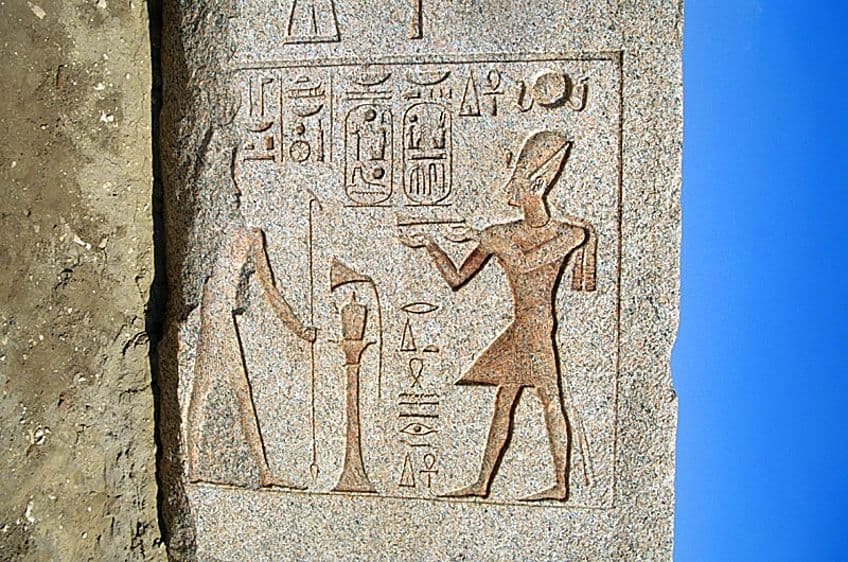
Many of these obelisks are intricately carved with themes from Ethiopian mythology and history as well as texts in Ge’ez script. Some of them were also used as religious sites and were considered to be infused with supernatural power. The majority of the Obelisks in Aksum, Ethiopia, were stolen as spoils of war by Italy during their rule in the 1930s. Only a handful remain, and many have been destroyed owing to negligence and an inadequate level of care. The Ethiopian government has been working to return these obelisks to Ethiopia, and some have been repatriated in recent years. In addition, they have also been attempting to restore and preserve the surviving obelisks still in Ethiopia.
Of course, Egyptian obelisks are the most well-known. The hieroglyphic inscriptions on ancient Egyptian obelisks contain historical, religious, and commemorative literature.
They typically feature pharaohs’ and deities’ titles and names, as well as details of the pharaoh’s achievements and tributes to the gods. Some obelisks also included depictions of the pharaoh giving gifts to the gods or vanquishing his adversaries. Obelisks were also religiously significant since they were thought to be endowed with the sun’s life-giving force. They were considered to have the capacity to safeguard and bless the region surrounding them, and they were occasionally thought to be living entities with the power to both see and hear.
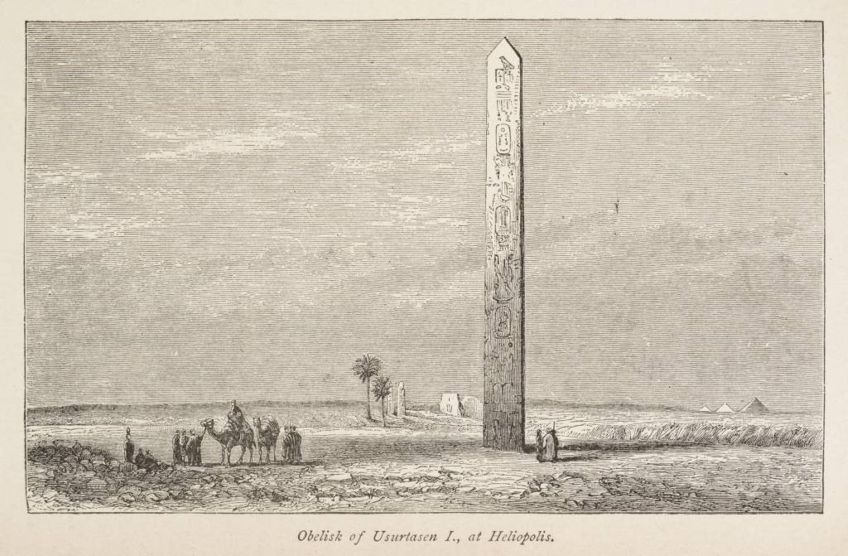
What does an obelisk represent in Egypt? The height of the obelisk, according to the ancient Egyptians, signified the primordial mound, which erupted from the chaos of the primal seas, as a symbol of the continuation of order and life. Obelisks were incredibly significant in Ancient Egypt and were only commissioned by pharaohs. Having one was a tremendous honor and a symbol of authority.
Erecting an obelisk was regarded as a rite of passage for a pharaoh, and many pharaohs undertook the work to memorialize their rule and establish their position in the pantheon of pharaohs.
Our List of Famous Obelisks
Now that we have learned a bit about the history of the obelisk, we can examine some of the most famous obelisks. As we have already mentioned, most of the obelisks around the world are actually Egyptian obelisks that were at one point moved from Egypt to various locations around the Roman Empire. Therefore, it’s not uncommon to see a large pillar with Egyptian inscriptions in many European public squares.
Flaminio Obelisk (10 BCE) in Rome, Italy
| Date Discovered or Relocated | 10 BCE |
| Estimated Age | c. 14th Century BCE |
| Height (meters) | 24 |
| Location | Rome, Italy |

Flaminio Obelisk (10 BCE); Livioandronico2013, CC BY-SA 4.0, via Wikimedia Commons
The Flaminio Obelisk is an antique Egyptian obelisk that was transported to Rome in 1589 and erected in Piazza Montecitorio. The obelisk is approximately 25 meters tall and composed of red granite. It was built in the 14th century BCE at the Temple of the Sun in Heliopolis, Egypt, during the reign of Pharaoh Rameses II. It was eventually relocated to Thebes’ Temple of Ra, where it stayed until it was taken to Rome during the reign of Roman Emperor Augustus.
Augustus had the obelisk moved to Rome as a victory memorial and a sign of Roman political dominance.
Domenico Fontana erected it at the Piazza del Popolo in 1589 at the order of Pope Sixtus V. It is among 13 ancient Egyptian obelisks found in Rome. Since its arrival in Rome, the obelisk has functioned as a landmark and a symbol of the Roman Empire’s ancient history, culture, and strength. It has been used as a landmark for various events such as processions and religious events.
Obelisk of St Peter’s Square (37 CE) in the Vatican City, Italy
| Date Discovered or Relocated | 37 CE |
| Estimated Age | c. 13th century BCE |
| Height (meters) | 25.5 |
| Location | Vatican City, Italy |

There are more upright Egyptian obelisks in Rome than any city or country in the world, including Egypt itself. Various Roman Emperors brought them all to Rome. This specific version is the only ancient Egyptian obelisk in Rome that has stood since Roman times. Unfortunately, nothing is known about its beginnings or which Pharaoh authorized its construction because it lacks hieroglyphs to document that information. It was likely mined in Egypt and intended for use in Heliopolis.
Between 30 and 28 BCE the red granite obelisk arrived in Alexandria under Augustus’ orders to be erected in the Julian Forum. The obelisk was brought to Rome by Gaius Caligula in 37 CE and was the biggest non-inscribed obelisk to ever leave Egypt.
The obelisk was first constructed amid gardens acquired from Caligula’s mother, and subsequently on the center of a circus begun by Caligula and finished during Nero’s reign. The original location for the obelisk is south of the basilica, and much of the area lies under the square and basilica. Because of the strong foundation on which the obelisk was erected, it stood in the same place for 1,500 years until being transported to its current location in Saint Peter’s Square.
Lateran Obelisk (357 CE) in Rome, Italy
| Date Discovered or Relocated | 357 CE |
| Estimated Age | c. 15th century BCE |
| Height (meters) | 45.7 |
| Location | Rome, Italy |

Pharaoh Thutmose III commissioned the obelisk for himself and a second for his father, however, neither was finished before his demise. Thutmose IV, Thutmose III’s grandson, completed the obelisks and had them raised at Karnak’s great temple of Amun. When it was finished, the obelisk was 32 meters tall, making it the highest in Egypt. Constantius II transported it and the second obelisk to Alexandria over the Nile in the early 4th century aboard an obelisk ship.
He wanted to transport both obelisks to Constantinople, the Roman Empire’s new capital. The Lateran Obelisk was never completed.
After several decades in Alexandria, Constantius II had the obelisk brought to Rome on his sole journey there in 357 CE. It was constructed beside the Egyptian obelisk known as the Flaminio, which had existed since 10 BCE and had been erected by Augustus to beautify the Circus Maximus’ spina. They both stayed there until after the collapse of the Western Roman Empire in the 5th century when the Circus Maximus was deserted and they were finally broken or hauled down. Over time, they were covered by mud and debris carried by a river.
Luxor Obelisk (1830s) in Paris, France
| Date Discovered or Relocated | 1830s |
| Estimated Age | c. 1250 BCE |
| Height (meters) | 23 |
| Location | Paris, France |
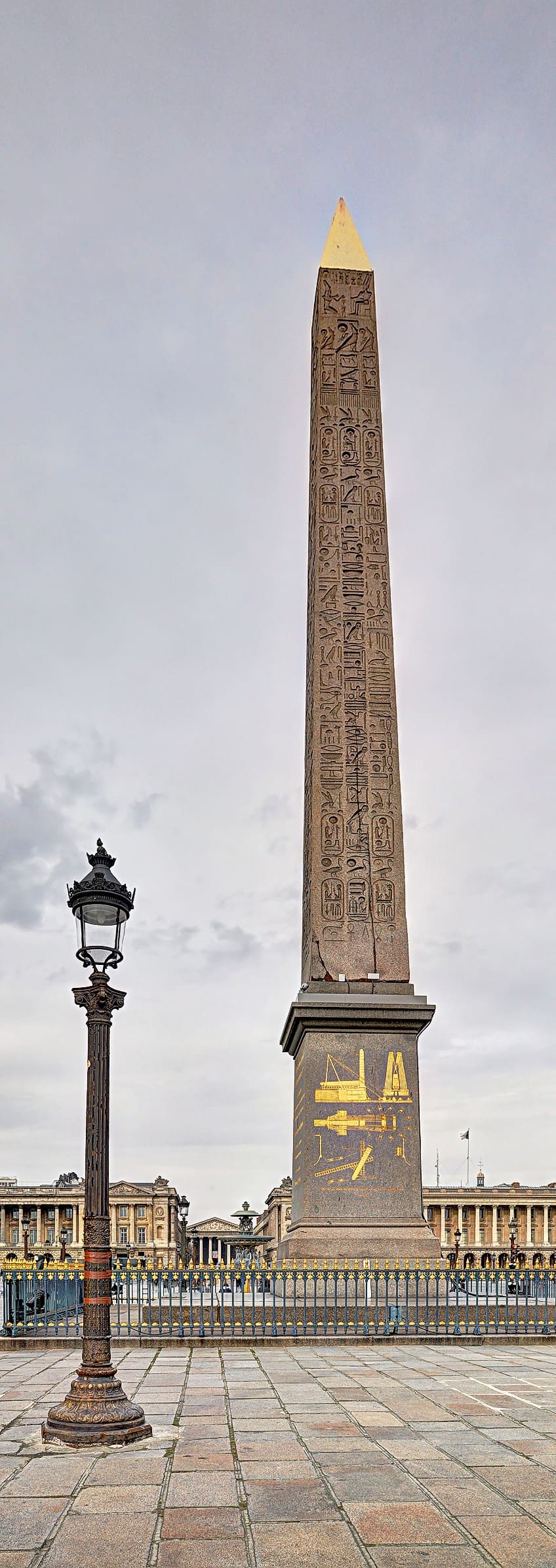
The Luxor Obelisk in France is one of two nearly 3,000-year-old Ancient Egyptian obelisks sculpted to occupy each side of the Luxor Temple entryway during Ramesses II’s reign. The western obelisk was relocated to the Place de la Concorde in Paris, France, in the 1830s, while the eastern obelisk can still be found in its original place in Egypt. The Luxor Temple was built some 150 years before Ramesses II.
Renovations, including the erection of the two obelisks, were carried out during his rule.
The obelisks were cut from a single block of red granite mined near Aswan some 160 kilometers south of Luxor, carried on a specially built boat, and lowered into place using ropes. These two Egyptian obelisks were quite different in height, with the one in Luxor standing higher. The shorter obelisk was erected farther out from the pylon and was put on a larger pedestal. To an onlooker, the obelisks may have looked to be the same height, and this architectural choice may have been intentional.
Heliopolis Obelisk (1868) in Cairo, Egypt
| Date Discovered or Relocated | 1868 |
| Estimated Age | c. 1950 BCE |
| Height (meters) | 21 |
| Location | Cairo, Egypt |

This Egyptian obelisk formerly stood at Heliopolis near the Temple of Ra. Its precise date of construction is unknown, however, it is thought to have been erected during the Middle Kingdom era of Pharaoh Senusret I, who governed Egypt from 1971 to 1926 BCE.
The obelisk was then relocated to the temple of Ra-Atum at Heliopolis, where it was rediscovered in 1868 by Auguste Mariette while he was excavating at the site.
The significance of Heliopolis’ sun cult is evident in both ancient pagan and modern monotheistic faiths. Each time the Egyptian bennu, renamed phoenix, was reborn, it transported the bones of its predecessor to the shrine of the sun god at Heliopolis, according to Greco-Roman mythology. Heliopolis is mentioned both explicitly and indirectly in the Hebrew Bible, mainly in relation to its famous pagan worship.
Cleopatra’s Needle (1881) in New York, United States
| Date Discovered or Relocated | 1881 |
| Estimated Age | 1475 BCE |
| Height (meters) | 21 |
| Location | New York, United States |
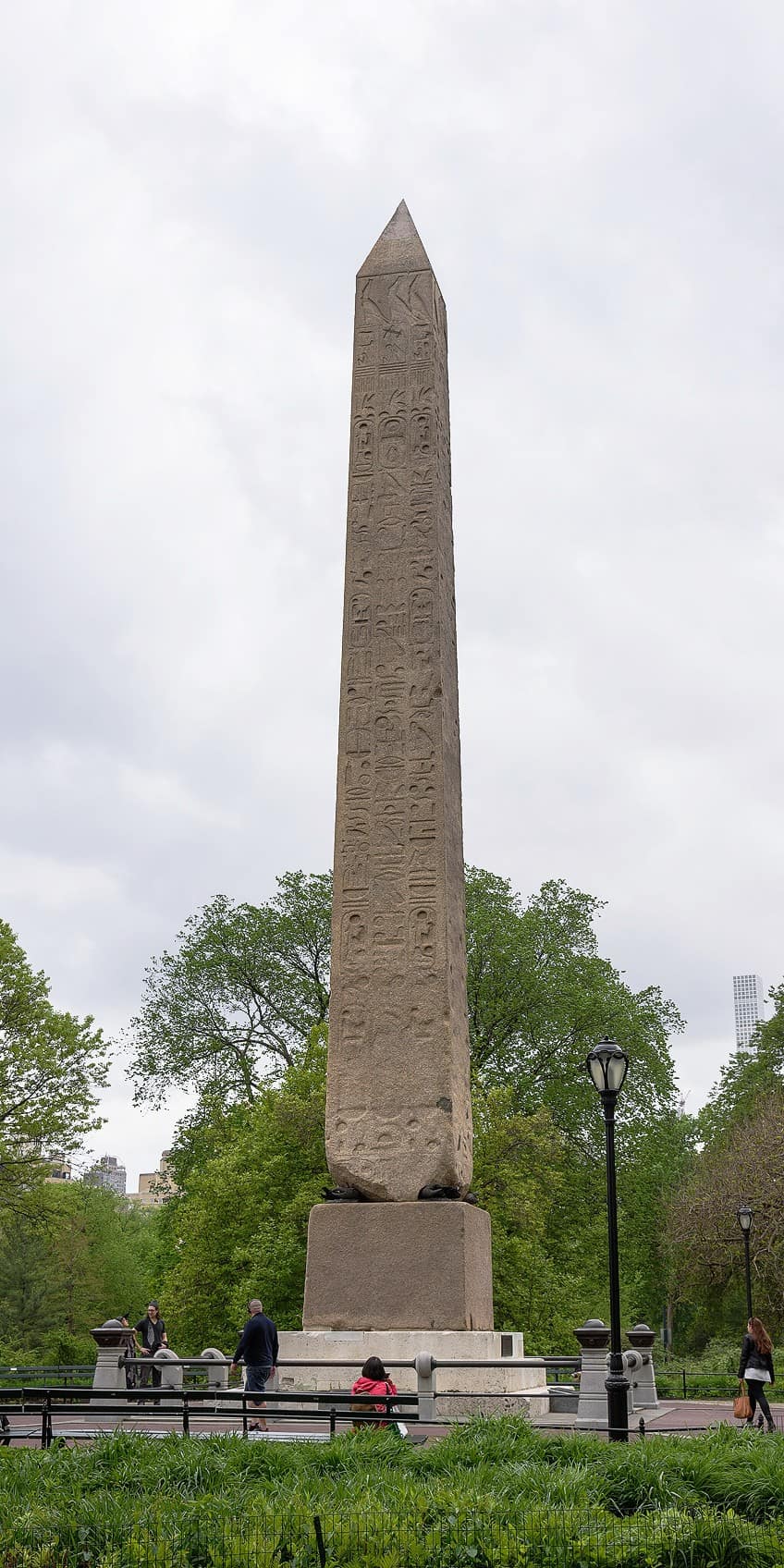
New York City’s Cleopatra’s Needle is one of two obelisks known as Cleopatra’s Needles that were transferred from the remains of the Caesareum of Alexandria in the 19th century. It was obtained in May 1877 as a gift from the Khedive in exchange for the US remaining friendly and neutral while the European powers – Britain and France – sought to gain political influence over the Egyptian government.
The Egyptian obelisk is made of red granite and measures around 21 meters tall. It is etched with Egyptian hieroglyphs.
Thutmose III ordered its construction in the Egyptian city of Heliopolis. The granite was imported from Aswan’s quarry near the Nile’s first cataract. Ramesses II added the inscriptions over 200 years later to celebrate his military achievements. A lieutenant commander from the United States Navy, Henry Honychurch Gorringe, was tasked with transporting the obelisk to New York from Alexandria.
Washington Monument (1884) in Washington D.C., United States
| Date Discovered or Relocated | 1884 |
| Estimated Age | 139 years |
| Height (meters) | 169 |
| Location | Washington D.C., United States |
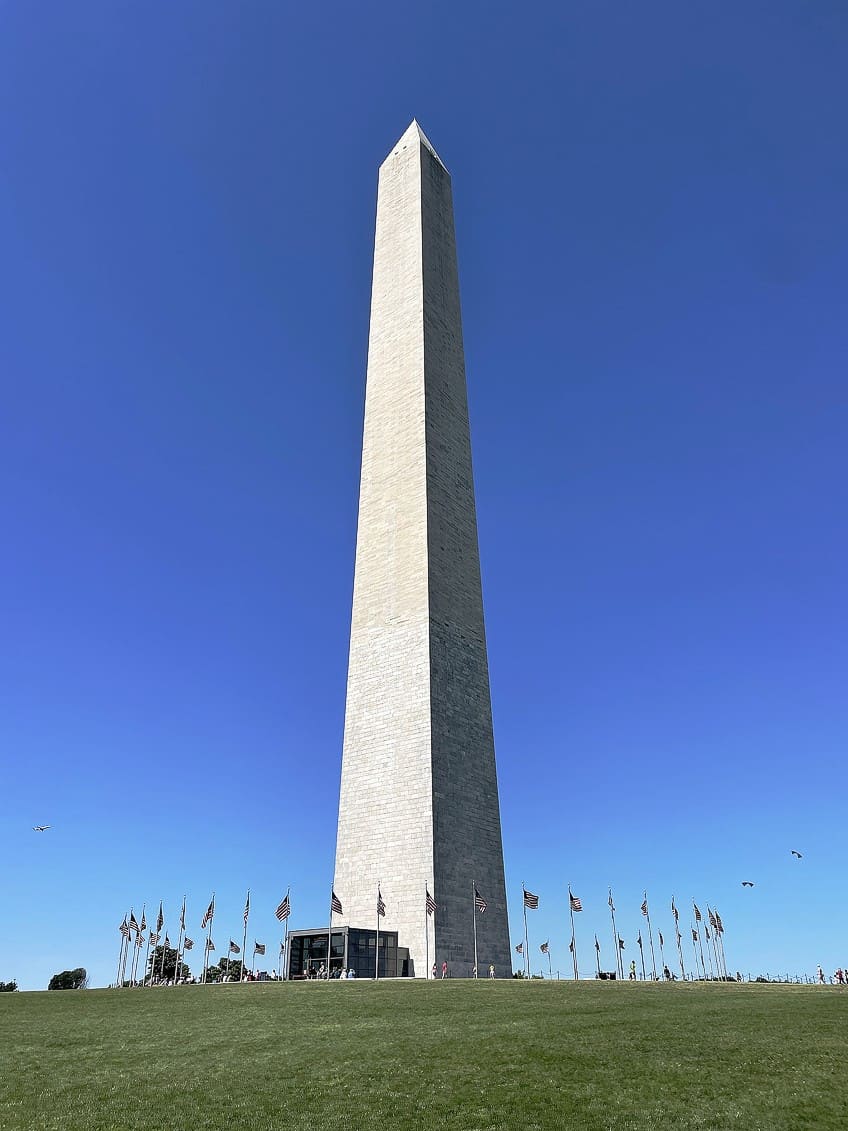
The Congress initially suggested a monument to Washington in 1783 when it granted funding to create a sculpture of the country’s military commander on horseback. When Pierre-Charles L’Enfant planned the city in 1791, he reserved the precisely surveyed center of the original District of Columbia, which was on a direct axis with the United States Capitol and the White House.
President Thomas Jefferson placed a stone memorial in the chosen spot in 1804; however, it subsequently sank into the swamp.
The project was almost instantly abandoned due to a variety of issues, including bureaucratic delay. The centennial of Washington’s birth renewed enthusiasm for a memorial. The Washington National Monument Society, formed in 1833 to choose a proposal for an appropriate tribute to the first president, picked Robert Mills’ idea for a tall obelisk with a circular base and 30 Doric columns. The monument did not open to the public until the 9th of October, 1888, after the completion of a steam elevator that allowed visitors to access the observation deck without having to climb the monument’s 897 stairs.
Unfinished Obelisk (1922) in Aswan, Egypt
| Date Discovered or Relocated | 1922 |
| Estimated Age | C. 1500 BCE |
| Height (meters) | 41.7 |
| Location | Aswan, Egypt |

This Egyptian obelisk is the largest ancient obelisk that has yet been uncovered and is situated in Aswan, Egypt, in the northern part of ancient Egypt’s stone quarries. Reginald Engelbach is known to have examined it thoroughly in 1922. It may have been built by Hatshepsut to accompany the Lateran Obelisk, which was originally located in Karnak before being transported to the Lateran Palace in Rome. The incomplete obelisk is roughly one-third bigger than any other Egyptian obelisk ever built. If completed and hoisted upright, it would have measured around 41.7 meters and weighed roughly 1,090 tonnes.
President Thomas Jefferson placed a stone memorial in the chosen spot in 1804; however, it subsequently sank into the swamp.
The obelisk’s lower side is still linked to the bedrock. The incomplete obelisk provides remarkable insights into ancient Egyptian stone-working processes, including markings from workers’ tools and ochre-colored lines indicating where and how they were working. An unfinished, partially worked obelisk foundation was also discovered in the Aswan quarries in 2005 along with the unfinished obelisk. Some rock engravings and relics were also unearthed, which may correspond to the location of the majority of the famed obelisks.
Obelisk of Axum (1935) in Axum, Ethiopia
| Date Discovered or Relocated | 1935 (restored in 2005) |
| Estimated Age | 1720 years |
| Height (meters) | 24 |
| Location | Axium, Ethiopia |

Axum, formerly the center of the Axumite kingdom that lasted over 1,000 years, is home to a 24-meter megalith encircled by a ring of lesser Obelisks. The 160-tonne monument, constructed in the 4th century by King Ezana, had stood for almost a thousand years until the colonial ambitions of a nation distant from Ethiopia arrived at her boundaries. Many people consider the Italian rule of Ethiopia to be a period of misery inside the country, with many long-hidden artifacts and national treasures seized by the invaders.
In the 1930s, Despite its massive dimensions, the Monolith of Axum was taken from the Ethiopians.
The Obelisk was discovered semi-submerged in a hole by a squad of Italian troops in 1935, and after more than two years in limbo, it was taken to Rome as a booty of war. It was re-erected at Portal Capena square, in front of the Ministry of Italian Relations in Africa, bringing this stolen booty of war to an ironic finish. The Obelisk remained in Rome until 2008. However, on the 4th of September in 2008, 1,700 years after the granite Obelisk was initially constructed and 70 years after it was stolen, it was returned to Ethiopia.
Obelisco de Buenos Aires (1936) in Buenos Aires, Argentina
| Date Discovered or Relocated | 1936 |
| Estimated Age | 86 years |
| Height (meters) | 67.3 |
| Location | Buenos Aires, Argentina |

The Obelisco de Buenos Aires is a national historical monument that was built in 1936 to mark the quadricentennial of the city’s founding. Construction on the obelisk commenced on the 20th of March, 1936, and was completed two months later. On the 20th of February, 1938, Roberto Mara Ortiz replaced Justo as President and named Arturo Goyeneche as the city’s new mayor.
The City Council authorized the destruction of the obelisk in June 1939, asserting that there were various aesthetic, economic, and public safety concerns..
The ordinance, nevertheless, was vetoed by the municipal executive authority, who described it as a deed without merit and legal substance because it changes the state of affairs derived by the executive power, and that it was a memorial under the authority and safekeeping of the country and is considered to be a part of its heritage. Throughout its existence, the obelisk has been subjected to vandalism, particularly politically charged graffiti. An activist group broke in and spilled paint from the top windows in the 1980s, prompting the local authorities to install a fence around the base in 1987. This decision sparked debate, but it finally proved beneficial in lowering the amount of defacing incidences.
Many ancient Egyptian obelisks could once be found in Egypt itself, however, many of them are now dispersed all across the world. Although it does mean that people do not have to travel all the way to Egypt to see them, it also brings up questions about the destruction and removal of another culture’s artifacts and history. It can actually be rather jarring to see a magnificent obelisk shape with all its magnificent Egyptian hieroglyphics capped with a Christian crucifix. However, there are also a few examples of modern obelisks that have simply been inspired by the obelisk shape.
Frequently Asked Questions
What Is an Obelisk?
An obelisk is a very tall stone structure that has four sides that are usually adorned with hieroglyphics, such as in the case of Egyptian obelisks. Many of the original Egyptian obelisks were taken from Egypt and transported to various places in the Rome Empire and across the world. However, there are also famous modern obelisks that are not from Egypt.
What Does an Obelisk Represent?
Obelisks represented the sun’s beams, which were viewed by the ancient Egyptians as a tangible representation of the god Ra. The obelisk’s pointed top was believed to penetrate the sky and extend up to the sun deity, and its four-sided, tapering design was intended to resemble a ray of sunshine. Obelisks also had political and theological connotations; they were linked to the pharaohs, who were viewed as the sun god’s earthly representations in life.
Justin van Huyssteen is a freelance writer, novelist, and academic originally from Cape Town, South Africa. At present, he has a bachelor’s degree in English and literary theory and an honor’s degree in literary theory. He is currently working towards his master’s degree in literary theory with a focus on animal studies, critical theory, and semiotics within literature. As a novelist and freelancer, he often writes under the pen name L.C. Lupus.
Justin’s preferred literary movements include modern and postmodern literature with literary fiction and genre fiction like sci-fi, post-apocalyptic, and horror being of particular interest. His academia extends to his interest in prose and narratology. He enjoys analyzing a variety of mediums through a literary lens, such as graphic novels, film, and video games.
Justin is working for artincontext.org as an author and content writer since 2022. He is responsible for all blog posts about architecture, literature and poetry.
Learn more about Justin van Huyssteen and the Art in Context Team.
Cite this Article
Justin, van Huyssteen, “What Is an Obelisk? – Top 10 Obelisks Found Around the World.” Art in Context. August 30, 2023. URL: https://artincontext.org/what-is-an-obelisk/
van Huyssteen, J. (2023, 30 August). What Is an Obelisk? – Top 10 Obelisks Found Around the World. Art in Context. https://artincontext.org/what-is-an-obelisk/
van Huyssteen, Justin. “What Is an Obelisk? – Top 10 Obelisks Found Around the World.” Art in Context, August 30, 2023. https://artincontext.org/what-is-an-obelisk/.









